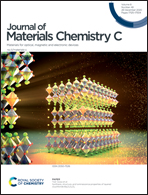A quantitative ratiometric fluorescent Hddb-based MOF sensor and its on-site detection of the anthrax biomarker 2,6-dipicolinic acid†
Abstract
Hydrothermal reactions of 1,3-di(3′,5′-dicarboxylphenyl)benzene (H4ddb) with Eu3+ and Tb3+ produced a series of hetero metal–organic frameworks (TbxEu1−x-Hddb). The optimized Tb0.875Eu0.125-Hddb showed high stability in organic solvents, HEPES buffer solution, NaOH and HCl solutions with pH = 2–11. TbxEu1−x-Hddb exhibited the combined characteristic transitions of Eu3+ (5D0 → 7FJ (J = 1–4)) and Tb3+ (5D4 → 7FJ (J = 6–3)). The sensitivity test of Tb0.875Eu0.125-Hddb revealed a linear response of I545/I613 = 0.0362·CDPA + 0.3176 with a LOD of 0.8494 μM, and seven interferents did not influence its detection performances. The paper-based MOF sensor Tb0.875Eu0.125-Hddb displayed obvious emission color conversions at CDPA = 60 μM, and a linear equation of G/R = 0.01091·CDPA + 0.12092 with a LOD of 19.1 μM by recognizing the RGB values of the paper-based MOF, showing a prospect for a rough on-site DPA detection. Tb0.875Eu0.125-Hddb and its paper-based sensor are quantitative ratiometric fluorescent sensors for DPA detection with high sensitivity and selectivity, and rapid response and convenience.



 Please wait while we load your content...
Please wait while we load your content...